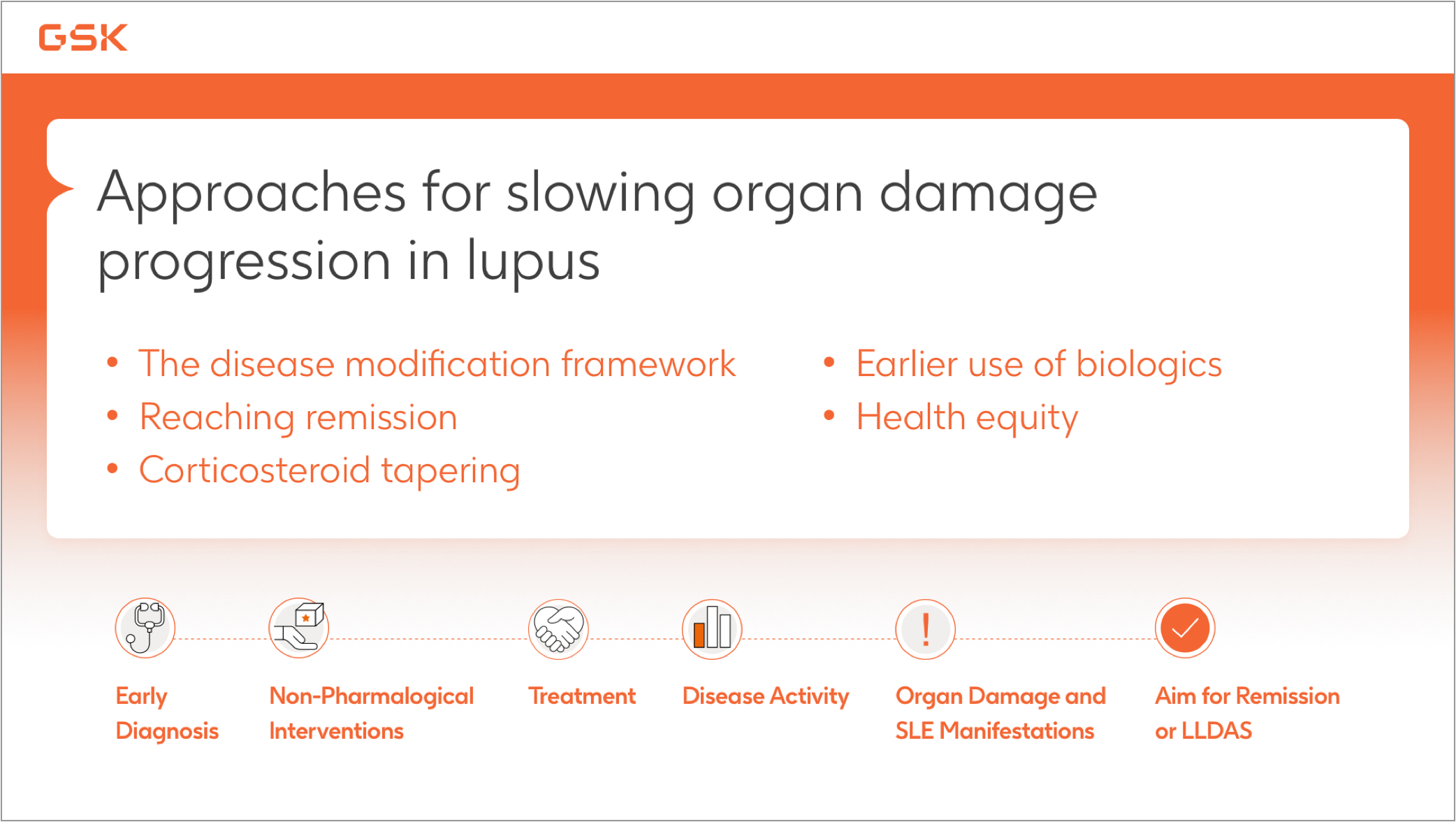Approaches for slowing organ damage progression in lupus Save
As irreversible organ damage can occur in ~50% of patients with lupus within five years of diagnosis,1 it is crucial for clinicians to recognize and reduce risk factors for damage accrual throughout the patient journey.
Applying the disease modification framework to minimize organ damage in patients with lupus
In recent years, frameworks such as lupus disease modification, remission, and low lupus disease activity state have become more established for use in clinical practice. A definition for disease modification in lupus was proposed as ‘minimizing disease activity with the fewest treatment associated toxicities and slowing or preventing organ damage progression’.2
Follow along with a representative case study presented by Dr. Maria Dall’Era and learn how clinicians can use the disease modification framework to help slow organ damage accrual.
Roadblocks to reaching remission in lupus
The 2023 EULAR recommendations for the management of lupus advocate for a treat-to-target approach, aiming for remission or low-level disease activity state.3 In this video, Dr. Michelle Petri summarizes the clinical criteria to attain these targets, and their association with reducing organ damage accrual. Dr. Petri also emphasizes the importance of increasing antimalarial use and decreasing the reliance on corticosteroids to meet these targets and help reduce rates of organ damage among patients.
The importance of corticosteroid tapering and earlier use of biologics for slowing organ damage accrual
Alongside the proposed definitions of disease modification and remission, lupus clinical management recommendations have evolved with the advancing treatment landscape. In the most recent 2023 EULAR recommendations for lupus, emphasis is placed on the importance of avoiding long-term and high-dose corticosteroid use, given their known associations with organ damage progression.3 One approach highlighted by EULAR to facilitate corticosteroid tapering is the earlier introduction of biologic immunosuppressives.3
Watch our short videos featuring Dr. George Bertsias and Dr. Dimitrios Boumpas for an overview of the 2023 EULAR recommendations for lupus management, and how implementing these could help to reduce risks of organ damage and improve the patient experience.
You can also download our visual summary of the updated EULAR recommendations for lupus here:
The importance of equitable care for slowing organ damage progression in lupus
Patients with lupus of Black African descent are more likely than Caucasian patients to experience comorbidities, be prescribed high dose corticosteroids, and have delayed access to specialty lupus care.4–6
In this video, Dr. Ashira Blazer and Dr. Anca Askanase walk through a representative case of a patient of Black African descent, and discuss a shared-decision making approach to help slow her organ damage progression whilst considering the impacts of health disparities in lupus.
References
1. Urowitz MB, et al. Arthritis Care Res (Hoboken). 2012;64(1):132-7.
2. van Vollenhoven R, et al. Lupus Sci Med. 2022;9(1):e000634.
3. Fanouriakis A, et al. Ann Rheum Dis. 2024;83(1):15-29.
4. Gaynon L, et al. ACR/ARHP Annual Meeting 2016; Nov 11–16; Washington (abstract #1970).
5. Barnado A, et al. Arthritis Res Ther. 2018;20(1):69.
6. Chandler MT, et al, Semin Arthritis Rheum. 2023;58:152122.
Visit the Lupus Educators’ Network to explore the latest scientific advances and expert opinions in lupus nephritis
VISIT THE LUPUS EDUCATORS' NETWORK PSE-US-2773 | May 2024






